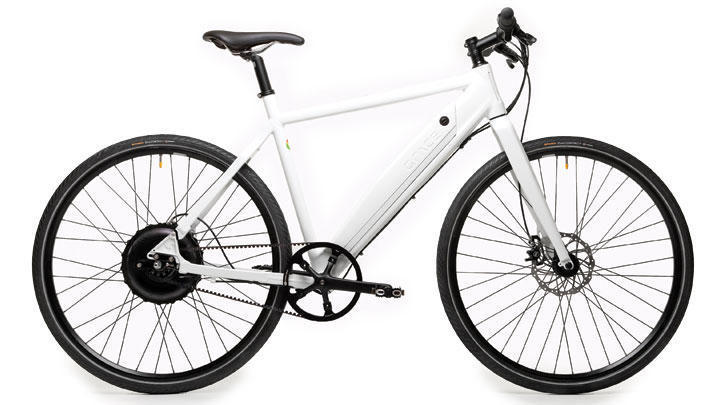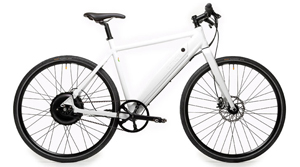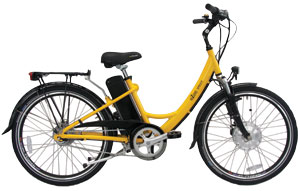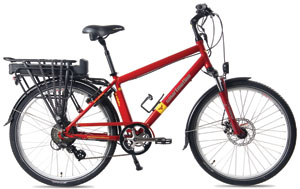Transport and technology
The e-bike revolution
Warren Judd

[This story first appeared in the Dec14-Jan15 issue of Green Ideas magazine.]
Electric bikes? Aren’t they a silly indulgence similar to those expensive Segway things? Well, so I thought until I tried one: then I changed my mind pretty quickly (see ‘The test-ride’).
Since 1998, e-bikes with lightweight batteries have moved from a curiosity to being both practical and impressive.
In fact it sometimes takes a careful observer to tell that a modern bike is electrically powered! These days the motor is hidden away in the front or rear hub, while the battery is a 4cm thick block often located beneath the rear carrier. As for the rest of the bike, these are typically well made (20–25kg), well-spec’d road bikes with quality gears and brakes. One of the few giveaways is an LCD control panel twice the size of a postage stamp on the handlebar.
What’s the appeal?
E-bikes are relatively cheap compared with cars or motorbikes, they’re economical to run and produce no emissions in operation; they are speedy and have a decent range, they don’t have to be registered, don’t need WOF inspections, and can drive on either the road or cycle-lanes, so avoid traffic congestion.
In China, where traffic in cities is causing great air pollution problems and restrictions on car ownership are increasing, there are estimated to be some 200 million e-bikes, with that number expected to more than double by 2020! While China is world HQ for e-bikes (both in sales and manufacturing) there are also millions in northern Europe. Last year Germans purchased 410,000 and Switzerland has 250,000.
Currently there are only around 2000 and 3000 here, though that number is growing as the concept catches on: one of the largest sellers is moving around 80 bikes a month.
How do they work?
You can ride a ‘pedal-assist’ e-bike in three different ways. You can ride it like any other bike, with your legs providing all the power. You can choose varying degrees of help, where the motor does some of the work as you pedal lightly. Or else you can sit back and relax while the bike does everything. Obviously the amount of work the motor does affects how long the battery charge lasts.
Environmentally, e-bikes have an obvious advantage as they produce none of the pollution of cars or scooters. However, in terms of climate change they are only as clean and green as the electricity supply they’re charged on. Obviously in a country where electricity was produced by burning coal, they would have no climate change advantage over cars – however in New Zealand, where 78 per cent of our power supply is from renewable sources, they are streets ahead. In fact, because most of the charging you do on an e-bike is likely to be overnight (when our power supply is purely hydro-electric) using an e-bike in New Zealand can easily be 100 per cent emissions-free.
Is an e-bike for you?
An e-bike is ideal for the person who wants to get a little exercise in their commute, but doesn’t want to battle it out through gales, or arrive at work sweaty. E-bikes are also a very cheap way to travel – and riding them is fun! You can zip noiselessly along at a good clip and savour the wind in your face.
The main buyers tend to be either 45-80 year olds getting back into cycling in a gentle way, or environmentally aware young folk.
There are folding models that will fit in the boot of your car without the need for a bike carrier, and mountain bike styles are also available, as are heavier load carriers.
Speed and range
In New Zealand, to be regarded as a bicycle (rather than a moped), an e-bike must have a motor of no more than 300W and is limited to a speed of 35km/h. An e-bike’s range depends on the capacity of the battery and how much assistance you get from it, but is typically 40-70km per charge. Batteries are usually 36v with a capacity of 10-12Ah, but you can upgrade to 15.6Ah at time of purchase for $124 from one supplier, for example. This could increase your range to close to 100km! Of course if you exhaust the battery while out, you simply pedal home as on a normal bike.
Price and running costs
A respectable road bike might set you back $500-$1000, but a decent e-bike will run from $1700-$3000, although on Trade Me some sell for less than $1000. In the past some cheap models have not proved very durable.
The lithium-ion battery is a significant part of the cost.
Mountain bikes and carrying models cost more, eg. $3800.
Bikes from perhaps 20 manufacturers, each with a handful of models, are available in New Zealand. The Japanese tool manufacturer Makita even sells a folding bike that runs from their 18v tool batteries!
Charging a typical e-bike battery takes between 4 and 7 hours and batteries can be recharged any time, with the cost of electricity for each recharge between 20 and 30 cents. So if you got a 75km range on a charge, that would be 0.3 cents/km. Commuting 10km each way for three days a week would consume less than 30 cents worth of electricity!
By comparison, driving a car the same distance would cost around $10 per week. And if you add in savings from car registration, insurance, WOF inspections and city parking, e-bikes become an even better proposition.
Similarly, if you normally catch the bus, and your present bus fare is $10 per day (and, say, weather prevented you from commuting on your e-bike two days a week) you would pay for your e-bike in fare savings within two years.
Batteries on good bikes carry a two year warranty and should last three to five years or longer. Should you need a new battery, they don’t come cheap: $799 for a top 12Ah model.
Drawbacks?
Apart from cost, the only problems associated with e-bikes are those common to all cycling. The main ones are vulnerability to bad weather and road accidents. While the power of an e-bike might get you out of a tight spot, mishaps at higher speeds can have more serious consequences, and motorists and pedestrians may underestimate your speed. They are terrific machines but riders need to be especially careful!
The test-ride
I’d not sat on a bike for decades, so my first few moments on an e-bike were pretty wobbly! Since this was a folding bike, it had small wheels, which didn’t help. But I soon regained a bit of balance and staggered off. I soon came to a rise requiring a bit of effort on the pedals, so I cautiously twisted the throttle that formed part of my left-hand grip. Immediately and silently, the bike accelerated up the hill and pedalling became a breeze. With almost no effort, I was doing 12… 15... 20km/h up the hill! The small LCD display attached to the handlebar showed speed as well as how much assistance I’d chosen the motor to give. By pressing a couple of small buttons on the edge of the display I could select more or less assistance from five levels. Little physical effort seemed to be needed from me at all, although I kept pedalling gently. As soon as I applied brakes, the throttle cut out. I was really pleased I’d worn a warm jacket because at 20-25km/h, the breeze was cold!
Because only modest exertion is required on these bikes, the seating position is upright, not at all the racing bike hunch. This means your back can be straight and you can look about much more easily.
Some e-bike options
Grace Easy

$4999
Designed and built in Germany, Grace e-bikes are a top-of-the-line-option and include features such as regenerative braking. Serious riders can fork out an extra $400 for front suspension.
See more at www.gracebikes.co.nz or contact Flux Westhaven in Auckland on 09 303 4030 for a list of stockists.
Ezee Sprint 7L

$2970
An ideal bike for commuting or rail-trail comfort, Sprints have been chosen by six New Zealand councils as their fleet bikes for their ease-of-use and high quality components.
See more at www.electricbikehub.co.nz. Stocked in 20 bike shops around New Zealand.
Smartmotion eUrban

$2275
A popular entry-level e-bike, with eight-speed Shimano gears, alloy suspension forks, 10ah battery (range of 40km to 50km), and five levels of pedal assist, plus a throttle. A rear-wheel drive makes hill climbs a breeze.
See more at www.electricbikes.co.nz or contact Electric Bikes NZ at 17 Bute Road, Browns Bay, Auckland on 09 479 9274.
